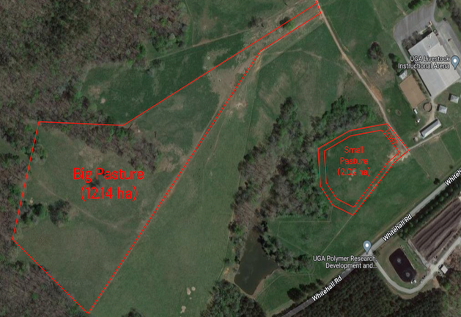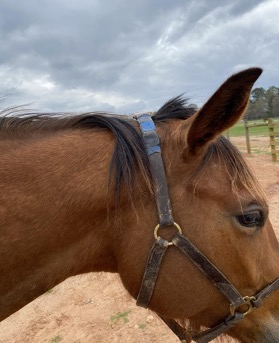By: Brooklyne Wassel, County Extension Coordinator/ANR Agent, Pike County
It is no secret that we have become more sedentary as people, leading to weight gain and an increase in associated health concerns. The same can be said for many of our animals, and horses are no exception. Many of the weight concerns that plague our modern horses are attributed to management practices such as excess nutrition and limited exercise. Feral horse populations typically cover vast ground each day to access adequate food supplies. By contrast, modern domestic horses are frequently kept in some combination of stalls, where diet can be restricted but activity is quite low, or on pastures where ample forage can lead to over conditioning and weight gain. So, what is the answer? Some owners choose to utilize dry lots to promote movement and limit caloric intake while others use a grazing muzzle to limit consumption on pastures. Both options can be challenging in their own ways.
Enter – “Paradise Paddocks.” It sounds like the answer to all of our horse owner woes with a name like that! The paradise paddock, or pasture track system, in theory promotes increased movement while still limiting caloric intake by creating a “track” which follows the full perimeter of a pasture. The idea is that horses must walk the entirety of the perimeter to get to food stations placed strategically around the track as compared to simply moseying in a dry lot or pigging out in the middle of a lush pasture. This concept is dependent on having multiple stops throughout the track for water, shelter, and hay so the horses have to continue walking to reach their desired resource. The idea is appealing to many, but it is greatly lacking in research-based data to validate these claims.
University of Georgia student Jenna Farmer Long recently conducted a study to evaluate pasture tracks and their effect on equine movement as well as their potential to cause environmental concerns such as erosion and sediment relocation. Horses were systematically moved through three housing locations to compare daily movement in a small pasture (5 acres, or 2 hectares), a large pasture (30 acres, or 12 hectares), and a pasture track (situated around the perimeter of the 5 acre pasture) (See Figure 1.)

Movement was monitored by GPS-equipped watches attached to the crownpiece of breakaway halters that horses wore (See Figure 2.) Eight horses were used in this study and were tracked by moving in pairs between each system with time for adjustment given to each before official data collection began in the new system. Environmental factors were also evaluated by comparing vegetative biomass (performed by cutting, drying, and weighing the grass from multiple randomly selected locations) and soil relocation (measured as the amount of sediment that moved onto artificial turf squares placed in designated locations) from both the small pasture and pasture track following rainfall events.

The study found that housing did not influence the horses’ daily distance traveled when comparing the large pasture, small pasture, and track system. This was further validated by conducting two off-site trials with horses on pasture tracks that were already in place and used as the horses’ normal housing environments. Though horses in the two off-site locations could not be statistically compared to the UGA horses due to differing times of study, the movement between sites was numerically similar which strengthened previous findings of no differences in activity level from the track system as compared to traditional pasture systems.
Researchers also found that the track system had an expected decrease in vegetative biomass over time compared to the small pasture due to horses quickly eating the limited available forage. This is the main way through which intake is more controlled in a pasture track (forage must be supplemented and can be limited to promote weight loss). However, the lack of vegetation quickly (within a matter of weeks) resulted in evidence of sediment relocation from the pasture track system, meaning that sediment runoff was noted following rain events from the pasture track but not from the small pasture. Unfortunately, that indicates that these systems may have environmental impacts on soil and water quality, and care should be taken to properly manage and improve footing in these tracks to prevent loss of topsoil and contamination of local waterways.
Though the findings of this study did not show that pasture tracks increased voluntary movement, it is important to note that movement did not decrease either even though the track was only 1/10 the size of the small pasture and 1/100 the acreage of the large pasture. Horses in the study also traveled the same distance regardless of pasture size (5 acre versus 30 acre), so pasture size according to this study is not an effective management method for increasing movement to control body condition and weight in horses. However, it would be important to do future research comparing pasture tracks to dry lots of equivalent acreage to determine if there is a threshold which begins to limit voluntary movement. In conclusion, pasture tracks may be effective as a weight control option due to the ability to limit forage intake without decreasing voluntary movement. However, the loss of vegetative cover that makes them effective in diet restriction also means that there is nothing to hold topsoil in place which can lead to erosion from the track. This sediment movement is especially problematic during rainy periods as it can result in sediment movement into local waterways in addition to muddy, sloppy footing in the track. Horse owners who want to implement pasture tracks should pay attention to the topography of their land and take steps to stabilize the track surface to prevent erosion.
Reference: Long, et al. (2024). Environmental impacts and daily voluntary movement of horses housed in pasture tracks as compared to conventional pasture housing. Journal of Equine Veterinary Science, vol 143.
